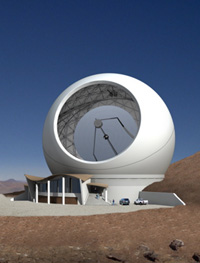Cerro Chajnantor Atacama Telescope
Coordinates: 22 ° 59 ′ 9.3 ″ S , 67 ° 44 ′ 25 ″ W.

The Cerro Chajnantor Atacama Telescope (CCAT) is a telescope under construction that will examine celestial objects in the terahertz or submm wavelength range. Cerro Chajnantor , located in northern Chile in the Atacama Desert , was chosen as the location . Originally planned was the largest telescope for this wavelength range with a diameter of 25 meters. Since the financing could not be secured in the end, some of the participating institutions decided in 2017 to implement a smaller CCAT-prime project with a mirror diameter of 6 m. Production of the mirror began at the end of 2018.
Location
The full functionality of the CCAT depends on the right climatic conditions. Since the terahertz radiation to be examined is absorbed by humidity , the location of the telescope must be as dry as possible. For this reason, the summit of Cerro Chajnantor in the Chilean Atacama desert, which is over 5600 meters high, was chosen. Here in winter the atmosphere contains only water vapor, which corresponds to a layer of water about 0.7 millimeters. With an altitude of 5612 meters above sea level, it would, together with miniTAO, be the highest telescope on earth. About 400 meters below is the Atacama Large Millimeter Array (ALMA).
Technical details
In the original design of CCAT, the diameter of the light but stable mirror was to be 25 meters, and a field of view of 20 arc minutes should be covered. In this context, the University of Cologne , the University of Bonn and Vertex Antennentechnik GmbH carried out a design study. Vertex Antennentechnik GmbH was already involved in the development of the antennas for ALMA .
The new CCAT-prime design has a smaller main reflector with a diameter of 6 meters, a secondary reflector of a similar size and is optimized for a large and flat field of view in order to be able to accommodate as many detectors as possible. A modified Dragone reflector arrangement is used which does not affect the polarization of the radiation being examined.
The construction of the components is again carried out by Vertex antenna technology and began production of the mirror in November 2018. The telescope is scheduled to go into operation in 2021.
aims
The CCAT-prime is intended to clarify open questions in cosmology and astrophysics . This includes:
- Investigation of the distribution and dynamics of the interstellar medium of the Milky Way and nearby galaxies through large-scale mapping in different spectral lines.
- Study of galaxy evolution by measuring the submm emission of individual dusty galaxies at high redshifts.
- Study of the earliest phases of galaxy evolution and the temporal course and spatial structure of cosmic reionization by measuring the resulting large-scale variations in the emission of the 157-μm line of ionized carbon.
- Determination of the velocities, temperatures, and transparency of galaxy clusters with the help of the Sunyaev-Zeldovich effect , to obtain information about the dark energy and the masses of neutrinos .
collaboration
Cornell University and other US and Canadian universities are involved in the development and construction of the CCAT . German support is provided by the University of Cologne , the University of Bonn and the Duisburg company Vertex Antennentechnik GmbH . The California Institute of Technology initially involved withdrew from the project in 2014 after an application for support from the National Science Foundation was unsuccessful.
Web links
Homepage of the Cerro Chajnantor Atacama Telescope
Individual evidence
- ↑ a b c Archived copy ( Memento of the original from July 27, 2011 in the Internet Archive ) Info: The archive link was inserted automatically and has not yet been checked. Please check the original and archive link according to the instructions and then remove this notice.
- ↑ http://www.astronews.com/news/artikel/2010/12/1012-017.shtml
- ↑ http://as.cornell.edu/news/breakthrough-telescope-be-built-chile
- ↑ Seeing How Stars Were Born: Fabrication of Six-meter CCAT-prime Telescope Has Begun. In: Max Planck Institute for Astrophysics. December 13, 2018, accessed December 16, 2018 .
- ^ CCAT. In: University of Colorado at Boulder: CASA Submillimeter Astrophysics Group. Retrieved December 16, 2018 .
- ↑ Corrado Dragone: Offset multireflector antennas with perfect symmetry and pattern polarization discrimination . In: Bell System Technical Journal . 57, 1978, pp. 2663-2684.
- ↑ Linda B. Glaser: Fabrication of powerful telescope begins. Cornell Chronicle, November 29, 2018, accessed December 16, 2018 .
- ↑ http://www.ccatobservatory.org/index.cfm , accessed April 27, 2015
